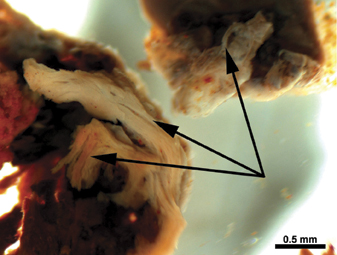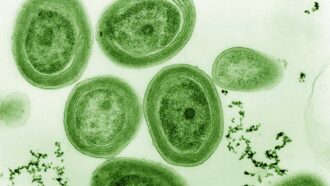Dino Flesh from Fossil Bone
Scientists may have found dinosaur blood vessels and cells inside a fossilized leg bone.
By Emily Sohn
The last dinosaurs on Earth died some 65 million years ago, but they left bits of themselves behind everywhere they lived. Around the world, dug-up bones have given scientists lots of clues about what the mega-reptiles were like.
 |
|
Demineralized fragments from a Tyrannosaurus rex leg bone contain fibrous areas (arrows) yielding structures that appear to be cells of a type found in living bone.
|
| Science |
Now, paleontologists have found an even juicier type of dino fossil—a Tyrannosaurus rex‘s upper leg bone with cells and blood vessels still intact. This dinosaur lived 68 million years ago. Researchers from North Carolina State University in Raleigh discovered the remains in what is now Montana.
The bone they dug up had been hardened by minerals, so the scientists started by soaking the bone in a solution to dissolve the minerals. A week later, the leftover material was soft and stretchy, which surprised the researchers.
Parts of the remains looked clear and stringy. They stayed that way even after being dried out and revived with water over and over again.
Some of the samples appeared to be a network of blood vessels. Out of these supposed blood vessels, the researchers were able to squeeze tiny, round, dark-red and deep-brown structures that seemed to be ancient blood cells.
There was also evidence of specialized bone cells. To test their conclusion, the researchers performed similar experiments on modern ostrich bones. They ended up with the same sorts of structures.
Scientists consider this discovery amazing because most fossils come from hard body parts, like bones and shells, which are sturdy and last a long time. Soft tissues, like skin, muscle, and organs, on the other hand, are much harder to come by because they tend to disintegrate quickly.
There may be many more dino cells out there. After the researchers finished inspecting the first T. rex sample, they then used the technique to uncover these same types of cells in samples from several other dinosaur fossils.
Paleontologists think that the new discoveries will help them better understand how fossils form. Future finds should also help flesh out how the dinosaurs lived.—E. Sohn
Going Deeper:
Perkins, Sid. 2005. Old softy: Tyrannosaurus fossil yields flexible tissue. Science News 167(March 26):195. Available at http://www.sciencenews.org/articles/20050326/fob1.asp .







